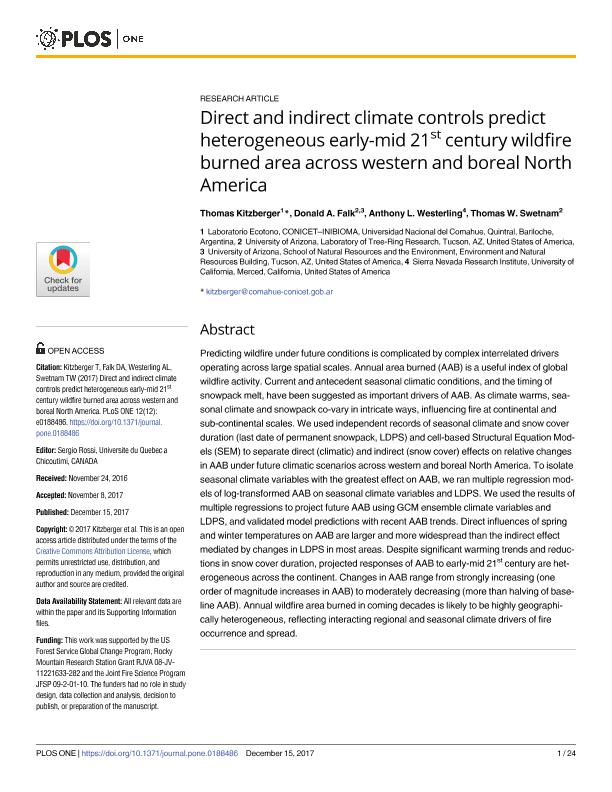Mostrar el registro sencillo del ítem
dc.contributor.author
Kitzberger, Thomas

dc.contributor.author
Falk, Donald A.
dc.contributor.author
Westerling, Anthony L.
dc.contributor.author
Swetnam, Thomas W.
dc.date.available
2018-11-13T19:48:43Z
dc.date.issued
2017-12-15
dc.identifier.citation
Kitzberger, Thomas; Falk, Donald A.; Westerling, Anthony L.; Swetnam, Thomas W.; Direct and indirect climate controls predict heterogeneous early-mid 21st century wildfire burned area across western and boreal North America; Public Library of Science; Plos One; 12; 12; 15-12-2017; 1-24; e0188486
dc.identifier.issn
1932-6203
dc.identifier.uri
http://hdl.handle.net/11336/64403
dc.description.abstract
Predicting wildfire under future conditions is complicated by complex interrelated drivers operating across large spatial scales. Annual area burned (AAB) is a useful index of global wildfire activity. Current and antecedent seasonal climatic conditions, and the timing of snowpack melt, have been suggested as important drivers of AAB. As climate warms, seasonal climate and snowpack co-vary in intricate ways, influencing fire at continental and sub-continental scales. We used independent records of seasonal climate and snow cover duration (last date of permanent snowpack, LDPS) and cell-based Structural Equation Models (SEM) to separate direct (climatic) and indirect (snow cover) effects on relative changes in AAB under future climatic scenarios across western and boreal North America. To isolate seasonal climate variables with the greatest effect on AAB, we ran multiple regression models of log-transformed AAB on seasonal climate variables and LDPS. We used the results of multiple regressions to project future AAB using GCM ensemble climate variables and LDPS, and validated model predictions with recent AAB trends. Direct influences of spring and winter temperatures on AAB are larger and more widespread than the indirect effect mediated by changes in LDPS in most areas. Despite significant warming trends and reductions in snow cover duration, projected responses of AAB to early-mid 21st century are heterogeneous across the continent. Changes in AAB range from strongly increasing (one order of magnitude increases in AAB) to moderately decreasing (more than halving of baseline AAB). Annual wildfire area burned in coming decades is likely to be highly geographically heterogeneous, reflecting interacting regional and seasonal climate drivers of fire occurrence and spread.
dc.format
application/pdf
dc.language.iso
eng
dc.publisher
Public Library of Science

dc.rights
info:eu-repo/semantics/openAccess
dc.rights.uri
https://creativecommons.org/licenses/by-nc-sa/2.5/ar/
dc.subject
Wildfire
dc.subject
Cliamte Change
dc.subject
Annual Area Burned
dc.subject
Snow Duration
dc.subject.classification
Otras Ciencias Biológicas

dc.subject.classification
Ciencias Biológicas

dc.subject.classification
CIENCIAS NATURALES Y EXACTAS

dc.title
Direct and indirect climate controls predict heterogeneous early-mid 21st century wildfire burned area across western and boreal North America
dc.type
info:eu-repo/semantics/article
dc.type
info:ar-repo/semantics/artículo
dc.type
info:eu-repo/semantics/publishedVersion
dc.date.updated
2018-10-23T16:18:30Z
dc.journal.volume
12
dc.journal.number
12
dc.journal.pagination
1-24; e0188486
dc.journal.pais
Estados Unidos

dc.journal.ciudad
San Francisco
dc.description.fil
Fil: Kitzberger, Thomas. Consejo Nacional de Investigaciones Científicas y Técnicas. Centro Científico Tecnológico Conicet - Patagonia Norte. Instituto de Investigaciones en Biodiversidad y Medioambiente. Universidad Nacional del Comahue. Centro Regional Universidad Bariloche. Instituto de Investigaciones en Biodiversidad y Medioambiente; Argentina
dc.description.fil
Fil: Falk, Donald A.. University of Arizona; Estados Unidos
dc.description.fil
Fil: Westerling, Anthony L.. University of California; Estados Unidos
dc.description.fil
Fil: Swetnam, Thomas W.. University of Arizona; Estados Unidos
dc.journal.title
Plos One

dc.relation.alternativeid
info:eu-repo/semantics/altIdentifier/doi/http://dx.doi.org/10.1371/journal.pone.0188486
dc.relation.alternativeid
info:eu-repo/semantics/altIdentifier/url/https://journals.plos.org/plosone/article?id=10.1371/journal.pone.0188486
Archivos asociados
